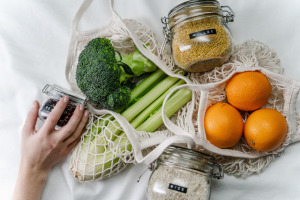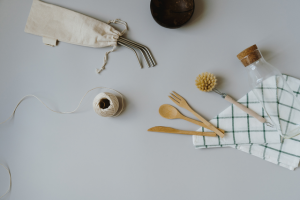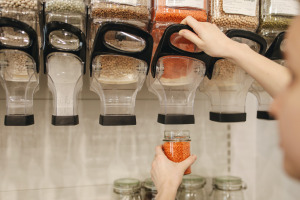Time for everyone’s favorite topic: saving the environment!
Well, it’s one of my favorite topics, and it’s about to be one of yours too (if it isn’t already). If you don’t already know, our planet has taken quite the beating. She’s overwhelmed with waste, climate change is a pressing issue, and we need to make some serious changes if we want her (and ourselves!) to survive. A super easy way to lend Mother Earth a helping hand is by changing our waste habits. Let’s take a look at some #facts:
-
Since 1960, annual waste generation in the United States has more than tripled — from 88.1 million tons to 292.4 million tons in 2018. That’s a lot of trash.
-
However, recycling and composting has greatly increased — yay!
-
We’re still landfilling a ton of our trash, though (well, 146.2 million tons in 2018, to be exact).
-
Waste is bad for the environment because it can emit toxic compounds during the decomposition process (if it does decompose) including methane gases and leachate. This all contributes to the greenhouse effect and other environmental issues.
It’s time to stop wasting our planet’s precious resources (pun intended). We need to get serious about our waste habits. We’re so passionate about this we decided to make it easy for you — here are 9 simple practices that can move you toward a zero waste lifestyle, so you can save the environment one reusable bag at a time.

View this post on Instagram
View this post on Instagram
1. Compost!
Start composting your food scraps, ladies! Veggie peels, fruit cores, all of it. We love this tip because you really get to see the immediate impact you’re making. Depending on where you live, you can see if your community has a composting service set up, which would be an even easier way to compost.
This article is a great beginner’s guide to composting. All you need to get started is something to put your scraps in, a composting bin (optional), and a spot in your yard for a food scrap pile. If you want to speed up the process, you can buy a worm composter — the worms will eat up the food scraps and pass it as waste, which helps break it down quicker. You could also get a composting tumbler, which doesn’t use insects and tends not to smell. Here are some compost bins to get you started:
2. Packaging, packaging, packaging!
Something I’ve seriously become more mindful of is what the things I buy are packaged in. Laundry detergent, soap, shampoo/conditioner, dish detergent — so many of these things are packaged in plastic that will just go straight to a landfill when you’re done with it. Here are a few ways to reduce this kind of waste:
Opt for the bigger size of your basics. And I don’t mean buy 3 bottles of soap at a time — I mean buy one super large soap refill that will last you for a while. It might still come in plastic but you’ll end up throwing away way less plastic than if you keep buying one small soap bottle every week. These articles about sustainable kitchen hacks and sustainable laundry hacks are also super helpful!
Shop in bulk. If a grocery store near you lets you buy items in bulk (where you bring your own container and fill it with dry goods), seriously start taking advantage of that. I have tons of quart-sized mason jars that I keep all my dry goods in and I love them — they’re great zero waste options and also look super cute in my pantry!
Buy items that use compostable/recyclable packaging. Think bamboo, paperboard, glass/metal, recycled plastic, or silicone. You may have to turn to the internet instead of your local store to accomplish this one, but it’s way worth it. This article has a bunch of brands that use eco-friendly packaging if you need a jump start!
3. Ditch the plastic bags and plastic wrap

All of the plastic bags — ziplocs, grocery bags, you name it. These single-use items go straight to a landfill when you’re done with them and seriously contribute to so much of our planet’s waste. Here are some alternative options:
Reusable grocery bags. I love my reusable grocery bags, and they’re some of my favorite zero waste products. I have these bags that fold up and are small enough to fit inside my wallet or pockets, making them super easy to carry around. We’re also crazy about these big, super durable SnapBaskets! I also make sure to keep some reusable bags in my trunk in case I ever forget to grab one when I’m leaving the house. Most stores also offer reusable bags for purchase at checkout, so if I’m ever in a bind, I’ll buy a couple of those instead of getting the free plastic ones. They’re still cheap and I love knowing I made a small, intentional difference.
Reusable zipper bags or tupperware. I don’t keep ziploc bags in the house anymore. Whenever I need to package food, I use my glass food storage containers. They’re a bit heavier and harder to carry around, but it’s worth it knowing that I won’t be throwing them out after I eat my sandwich. You could also opt for some reusable, dishwasher friendly zipper bags — a zero waste alternative that will last for ages.
Beeswax wrap. I love this stuff! I like it way better than I ever liked plastic wrap because it actually sticks to whatever I’m trying to cover. Beeswax wrap works perfectly to put over bowls if you need to save something in the fridge, or to wrap sandwiches or fruit in. Just make sure your buy is good quality and made in the US! Etsy is a good place to look.
4. Opt for bamboo toothbrushes and reusable straws

Sometimes it’s the little things we use daily that have the biggest impact. Take toothbrushes and straws, for example. You probably haven’t even thought about the harm they could be causing the environment — they’re so small, how could they really be doing any damage?
Well, imagine millions of other people thinking that way, too. Now that’s a lot of waste! So instead of opting for plastic toothbrushes, buy toothbrushes made with sustainable materials. My favorites are these bamboo toothbrushes. I do notice that I go through them a bit faster than I used to go through toothbrushes, but they’re still super inexpensive and bamboo is very eco-friendly.
Instead of plastic straws, buy some reusable straws. Many of them are super cute and dishwasher-friendly, and some are even foldable so you can take them with you on the go and say no to plastic straws at restaurants!
5. Say no to free samples

I know, the little plastic spoons and cups are tiny, but they actually make a huge impact. Trust me, I know — I used to work at an ice cream shop, and it’s incredible the amount of tiny plastic spoon waste we’d accumulate from just a single summer’s day of customers sampling flavors. It was insane. (Thankfully, we eventually switched to eco-friendly wooden spoons for sampling.)
If you really want samples, check and see what the sampling spoons are made of. If they’re made of plastic, feel free to ask if you can try several flavors in a small cup — that way, you can just use one spoon for all your samples. Or forego the samples altogether and ask what the employee recommends! They’re bound to give you the inside scoop on the best flavors.
6. Reusable water bottles are the planet’s friend
Stop. Buying. Plastic. Water. Bottles. Please. There’s really no need for them in any circumstance. Need something for your kid to take to soccer practice? Get a reusable water bottle. What about that party? Isn’t it standard to have water bottles available at a party? Opt for a giant drink dispenser instead. What about that road trip we’re going on? If you really need to have a bunch of water on hand on the road, buy gallon jugs instead of water bottles and take some reusable water bottles in the car with you that you can refill. See? So many options!
7. Shop small and sustainable, donate, and thrift
We’ve already talked about how much harm the fashion industry causes the environment. If you do need to buy new clothes, make sure you’re buying them from sustainable companies (the app Good On You can help you find awesome brands). We’ve also dedicated an article to the inspiring sustainable footwear brands who are changing the game. If you don’t absolutely need something to be new, try thrift shopping. You can get some killer finds thrifting, especially if you live in an urban area. I live in Portland, OR and the thrift stores here are amazing, I don’t think I’ve bought a single new piece of clothing since I’ve been here!
Instead of trashing your old clothes, donate them to your favorite local thrift shop… Or better yet, donate them to a non-profit organization that is in need of clothes to directly help a cause. For tips on de-cluttering your closet, we have the perfect guide for you here. You could even try to make some money through services like Poshmark or Thredup, or you could sell them on Facebook Marketplace. These zero waste options are win-wins for everyone: you’re making a bit of cash, someone else is getting new-to-them styles, and Mother Earth doesn’t have to try to decompose your hand-me-downs!
8. Get creative with DIY repurposing
Instead of tossing items that have run their course, see if you can repurpose or refurbish them. If you have old, torn sheets or pillowcases, make them into handkerchiefs, napkins, or cleaning cloths. Old towels can be cut up and used as washcloths. You can look into reupholstering that old couch or chair you’re tired of to give it a brand new look without the waste of throwing it out completely. Save your bottle caps and make some bottle cap wall art. Old glass hot sauce or kombucha bottles make adorable wildflower vases. All you DIY-ers out there will have a field day with this zero waste practice!
9. Ditch the pads and tampons
I know what you’re thinking: this girl’s trying to make our periods even more difficult? Actually, lady, I’m going to make them about a million times easier.
Not only are pads and tampons super bad for the environment, they’re also just not fun to wear. Pads feel like diapers and tampons always seem to leak. My favorite alternative? Menstrual cups!
Seriously, if you haven’t jumped on the cup bandwagon yet, you have to. Menstrual cups are typically made out of silicone and they’ll last for years. Best of all, they’re totally leak-proof and you can’t even feel them (as long as they’re inserted right). They even helped get rid of my cramps! I love love love them and will never use anything else ever.

What do you think of these super easy zero waste practices? Will you incorporate any of them into your lifestyle? Let us know in the comments!
For More About Sustainability, You Should Read:
6 Simple Swaps For A More Environmentally-Conscious Kitchen
Celebrating Earth Day With 4 Key Steps To More Sustainable Shopping


